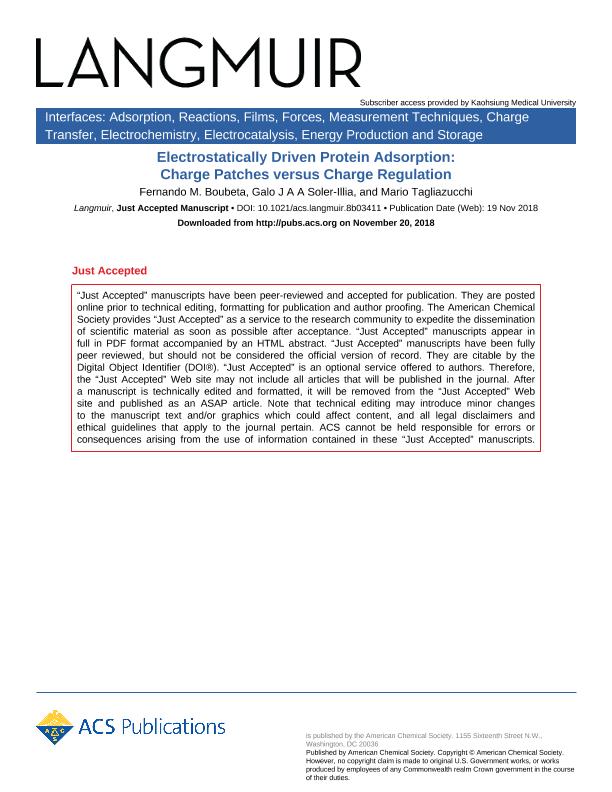Mostrar el registro sencillo del ítem
dc.contributor.author
Boubeta, Fernando Martín

dc.contributor.author
Soler Illia, Galo Juan de Avila Arturo

dc.contributor.author
Tagliazucchi, Mario Eugenio

dc.date.available
2019-11-22T18:00:46Z
dc.date.issued
2018-12
dc.identifier.citation
Boubeta, Fernando Martín; Soler Illia, Galo Juan de Avila Arturo; Tagliazucchi, Mario Eugenio; Electrostatically Driven Protein Adsorption: Charge Patches versus Charge Regulation; American Chemical Society; Langmuir; 34; 51; 12-2018; 15727-15738
dc.identifier.issn
0743-7463
dc.identifier.uri
http://hdl.handle.net/11336/89586
dc.description.abstract
The mechanisms of electrostatically driven adsorption of proteins on charged surfaces are studied with a new theoretical framework. The acid-base behavior, charge distribution, and electrostatic contributions to the thermodynamic properties of the proteins are modeled in the presence of a charged surface. The method is validated against experimental titration curves and apparent pK a s. The theory predicts that electrostatic interactions favor the adsorption of proteins at their isoelectric points on charged surfaces despite the fact that the protein has no net charge in solution. Two known mechanisms explain adsorption under these conditions: (i) charge regulation (the charge of the protein changes due to the presence of the surface) and (ii) charge patches (the protein orients to place charged amino acids near opposite surface charges). This work shows that both mechanisms contribute to adsorption at low ionic strengths, whereas only the charge-patch mechanism operates at high ionic strength. Interestingly, the contribution of charge regulation is insensitive to protein orientation under all conditions, which validates the use of constant-charge simulations to determine the most stable orientation of adsorbed proteins. The present study also shows that the charged surface can induce large shifts in the apparent pK a s of individual amino acids in adsorbed proteins. Our conclusions are valid for all proteins studied in this work (lysozyme, α-amylase, ribonuclease A, and β-lactoglobulin), as well as for proteins that are not isoelectric but have instead a net charge in solution of the same sign as the surface charge, i.e. the problem of protein adsorption on the "wrong side" of the isoelectric point.
dc.format
application/pdf
dc.language.iso
eng
dc.publisher
American Chemical Society

dc.rights
info:eu-repo/semantics/openAccess
dc.rights.uri
https://creativecommons.org/licenses/by-nc-sa/2.5/ar/
dc.subject
Protein adsorption
dc.subject
Poisson boltzmann
dc.subject
Electrostatics
dc.subject
Charge regulation
dc.subject.classification
Físico-Química, Ciencia de los Polímeros, Electroquímica

dc.subject.classification
Ciencias Químicas

dc.subject.classification
CIENCIAS NATURALES Y EXACTAS

dc.title
Electrostatically Driven Protein Adsorption: Charge Patches versus Charge Regulation
dc.type
info:eu-repo/semantics/article
dc.type
info:ar-repo/semantics/artículo
dc.type
info:eu-repo/semantics/publishedVersion
dc.date.updated
2019-10-16T15:23:10Z
dc.journal.volume
34
dc.journal.number
51
dc.journal.pagination
15727-15738
dc.journal.pais
Estados Unidos

dc.description.fil
Fil: Boubeta, Fernando Martín. Consejo Nacional de Investigaciones Científicas y Técnicas. Oficina de Coordinación Administrativa Ciudad Universitaria. Instituto de Química, Física de los Materiales, Medioambiente y Energía. Universidad de Buenos Aires. Facultad de Ciencias Exactas y Naturales. Instituto de Química, Física de los Materiales, Medioambiente y Energía; Argentina
dc.description.fil
Fil: Soler Illia, Galo Juan de Avila Arturo. Universidad Nacional de San Martin. Instituto de Nanosistemas; Argentina. Consejo Nacional de Investigaciones Científicas y Técnicas; Argentina. Universidad de Buenos Aires. Facultad de Ciencias Exactas y Naturales; Argentina
dc.description.fil
Fil: Tagliazucchi, Mario Eugenio. Consejo Nacional de Investigaciones Científicas y Técnicas. Oficina de Coordinación Administrativa Ciudad Universitaria. Instituto de Química, Física de los Materiales, Medioambiente y Energía. Universidad de Buenos Aires. Facultad de Ciencias Exactas y Naturales. Instituto de Química, Física de los Materiales, Medioambiente y Energía; Argentina
dc.journal.title
Langmuir

dc.relation.alternativeid
info:eu-repo/semantics/altIdentifier/url/http://pubs.acs.org/doi/10.1021/acs.langmuir.8b03411
dc.relation.alternativeid
info:eu-repo/semantics/altIdentifier/doi/http://dx.doi.org/10.1021/acs.langmuir.8b03411
Archivos asociados
